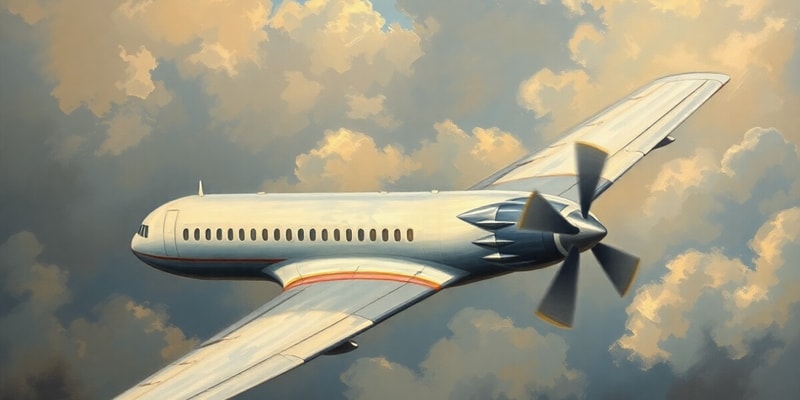Podcast
Questions and Answers
Which software type is categorized as user certifiable?
Which software type is categorized as user certifiable?
What is the primary use of Field-Loadable Software (FLS)?
What is the primary use of Field-Loadable Software (FLS)?
Which option does not directly relate to maintenance operations?
Which option does not directly relate to maintenance operations?
Which of the following software types requires continued airworthiness consideration?
Which of the following software types requires continued airworthiness consideration?
Signup and view all the answers
In the context provided, which statement is true about the Cabin Database (CDB)?
In the context provided, which statement is true about the Cabin Database (CDB)?
Signup and view all the answers
Study Notes
Software Management Control (5.13) Learning Objectives
- Describe restrictions on software management and control (Level 2)
- Describe airworthiness requirements for software management and control (Level 2)
- Describe possible catastrophic effects of unapproved changes to software programs (Level 2)
Classification of Aircraft Software Systems
- Software is used in aircraft systems for computer programming.
- It's used in all computer-based systems.
- Includes: engine control systems, bleed air control systems, power generation and control systems, fire protection systems, aircraft instrument displays.
- Modern aircraft heavily rely on computer software for navigation and flight management.
- Continuous software updates are necessary due to changing navigational requirements.
- Changes may be due to airline flight route changes, air traffic control changes, or changes in waypoint positions.
- Built-In Test Equipment (BITE) communicates with other systems to test and identify problems.
Multifunction Control Display Unit (MCDU)
- Programmed with software to update or input data, test and identify faults for communication with multiple systems.
Software Control
- Each aircraft equipment and system needing software has a Software Level assigned, based on the severity of the possible software error effect on safety, crew and passengers.
- Software levels are set by DO-178C Software Considerations in Airborne Systems and Equipment Certification (jointly prepared by RTCA SC-167 and EUROCAE WG-12).
Software Levels (DAL Danger Levels)
- Software is assigned a level (A, B, C, D, or E) based on potential safety-related failures.
- The level determines its probability of failure.
- A - Catastrophic: failure prevents safe aircraft continuation/landing.
- B - Hazardous: failure results in serious or fatal injuries.
- C - Major: failure causes discomfort or injuries.
- D - Minor: failure causes minor inconvenience.
- E - No Effect: failure has no effect.
- Flight control computers, fly-by-wire, full authority digital engine control, flight displays, air data systems are some examples of systems controlled by software.
Flight software design assurance levels and acceptable probabilities of failure
- Software is treated like an aircraft component during certification, investigation, and control procedures.
- Five levels of certification are associated with specific aircraft components.
- Level A - Catastrophic: Includes flight control computer, fly-by-wire, full authority digital engine control, flight displays, and air data systems.
Level B - Hazardous, Level C - Major, Level D - Minor, Level E - No Effect
- Hazardous failure condition examples: Autopilot, autothrottle, ice protection, standby flight displays, instrument landing systems, landing gear control.
- Major failure condition examples: Navigation systems (GPS), yaw damper, environmental control systems.
- Minor failure condition examples: Flight data recorder, data acquisition system, cabin lighting.
- No effect failure condition examples: In-flight entertainment.
Software Types
- Two main types: Field-Loadable Software (FLS), Preloaded or Resident Software.
- FLS contains data tables loaded into the aircraft by maintenance personnel without system/equipment removal. Uniquely identified part numbers.
Preloaded or Resident Software
- Cannot be changed without removing and sending the system to a workshop.
- Used in inaccessible areas or high contamination areas.
Loadable Software Aircraft Part (LSAP)
- Considered a part of the aircraft approved design requiring specific documentation.
Non-Loadable Software Aircraft Part or Aeronautical Database
- Not part of certified aircraft configuration.
- May include navigation, flight planning, and terrain awareness functions.
- Routinely updated without formal modification approvals.
Databases
- Two significant types: LSAP and Aeronautical Databases.
- Model/Engine Database (MEDB) is LSAP software creating a customised performance database specific to aircraft navigation system.
- Aeronautical Database (ADB) is not considered an aircraft component, but may be managed as one. Provides navigation and route information for Flight Management Systems.
Operator Modifiable Software (OMS)
- User-Modifiable Software (UMS) and User-Certifiable Software (UCS) allow operators to adjust system functions.
User-Certifiable Software (UCS)
- Allowable modifications that require operator-acceptable certification.
Supplier Controlled Software (Operational Program Software (OPS))
- Program instructions for a Line-Replaceable Unit (LRU).
- Each version has unique software part numbers.
Operational Program Configuration (OPC)
- Software that controls LRU functions.
- Eliminates the need for pin programming.
- Lists modules using LSAPs applicable to specific aircraft.
Software Media
- Various forms used to transport and distribute software, including discs, memory cards, and via the internet.
Software Version
- Specific software item at a designated revision status.
- Commonly in format A.BB (A=major, BB=minor version).
Target Hardware
- Hardware for loading FLS, like Enhanced Ground Proximity Warning System (EGPWS), Flight Control Computer (FCC), Flight Management Computer (FMC).
Sourcing Software
- Software obtained from acceptable sources with documentation confirmation, performance, and accuracy.
Software Data Loading
- Methods for loading software and data updates, including portable and airborne loaders.
- Loaders may be integrated into the avionics system or portable.
- Strict adherence to maintenance manuals is critical.
Portable Maintenance Access Terminal (PMAT)
- High-speed data transfer using media like 3.5-inch discs or CD-ROMs.
- Can be permanently affixed to the aircraft or portable.
FLS Loading and Certification
- Establishing the process for loading FLS into target hardware.
- Required records and documentation for verification and compliance.
- Crucial to ensure adherence to loading procedures and maintain aircraft reliability.
Electronic Distribution of Software (EDS)
- Distributing software electronically without physical media; more efficient.
Field-Loadable Software Procurement and Documentation
- LSAPs/databases/UMS obtained from approved sources with accompanying documents.
FLS Storage Media Handling
- Procedures to ensure FLS and storage media reliability using appropriate storage methods and avoiding contaminants.
Replication of FLS
- Procedures for making copies of software using proper processes and maintaining traceability.
Procedures
- Operators must have procedures to determine each aircraft's configuration of equipment and software to maintain aircraft consistency.
- Procedures should follow documentation from the procurement, distribution to implementation and final acceptance and testing.
Case Study: Maintenance management exposition
- Changing aircraft software might alter aircraft operating characteristics.
- Potential areas of impact include engine systems, navigational systems, and flight control systems.
Studying That Suits You
Use AI to generate personalized quizzes and flashcards to suit your learning preferences.
Related Documents
Description
This quiz explores the critical aspects of software management and control in aircraft systems, including restrictions, airworthiness requirements, and the potential effects of unapproved changes. Understand how software integration affects engine control, navigation, and system safety in modern aviation.



